GMC SAVANA 1998 User Guide
Manufacturer: GMC, Model Year: 1998, Model line: SAVANA, Model: GMC SAVANA 1998Pages: 388, PDF Size: 20.04 MB
Page 11 of 388
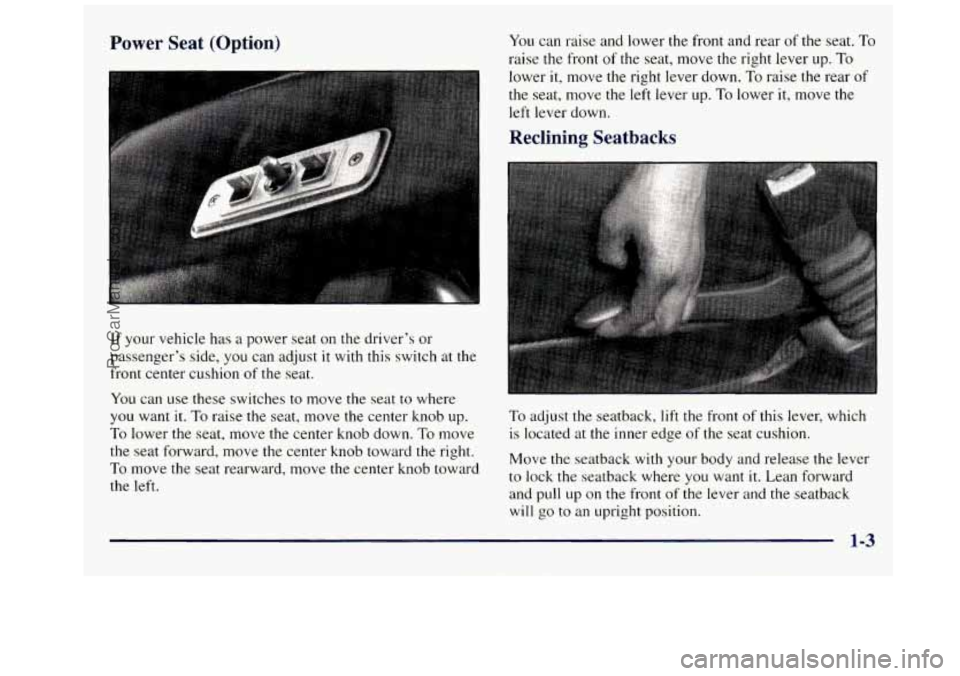
Power Seat (Option)
If your vehicle has a power seat on the driver’s or
passenger’s side, you can adjust it with this switch at the
front center cushion
of the seat.
You can use these switches to move the seat to where
you want
it. To raise the seat, move the center knob up.
To lower the seat, move the center knob down. To move
the seat forward, move the center knob toward the right.
To move the seat rearward, move the center knob toward
the left.
You can raise and lower the front and rear of the seat. To
raise the front of the seat, move the right lever up. To
lower it, move the right lever down. To raise the rear of
the seat, move the
left lever up. To lower it, move the
left lever down.
Reclining Seatbacks
To adjust the seatback, lift the front of this lever, which
is located at the inner edge
of the seat cushion.
Move the seatback with your body and release the lever
to lock the seatback where you want it. Lean forward
and pull
up on the front of the lever and the seatback
will go to an upright position.
ProCarManuals.com
Page 12 of 388
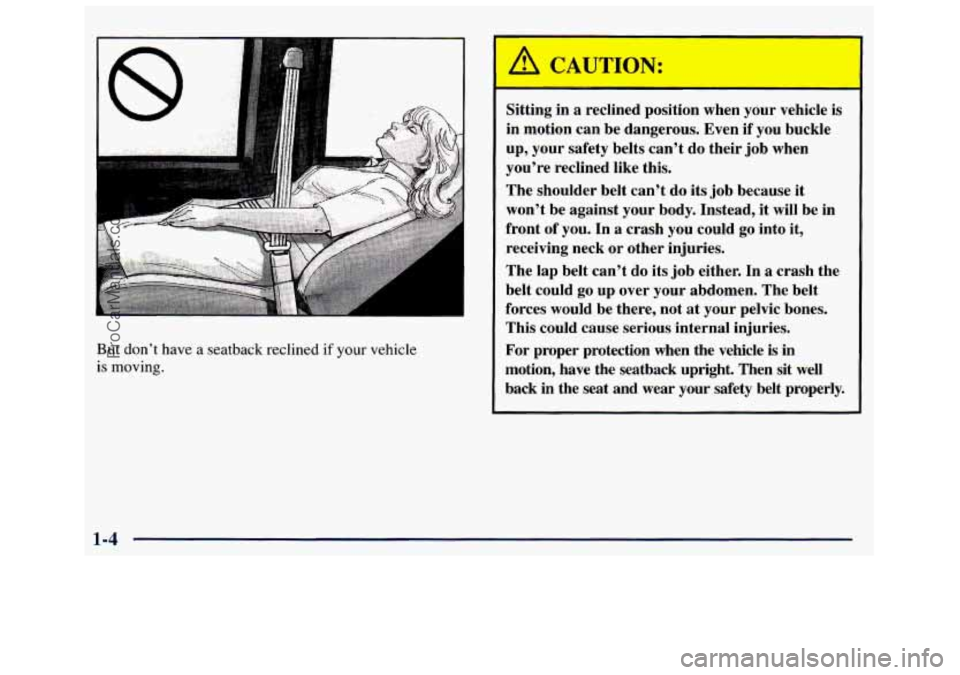
But don’t have a seatback reclined if your vehicle
is moving.
A CAUTION:
Sitting in a reclined position when your vehicle is
in motion can be dangerous. Even if you buckle
up, your safety belts can’t do their job when
you’re reclined like this.
The shoulder belt can’t do its job because it
won’t be against your body. Instead, it will be in
front of you. In
a crash you could go into it,
receiving neck
or other injuries.
The lap belt can’t do its job either. In a crash the
belt could go up over your abdomen. The belt
forces would be there, not at your pelvic bones.
This could cause serious internal injuries.
For proper protection when the vehicle is in
motion, have the seatback upright. Then sit well
back in the seat and wear your safety belt properly.
1-4
ProCarManuals.com
Page 13 of 388
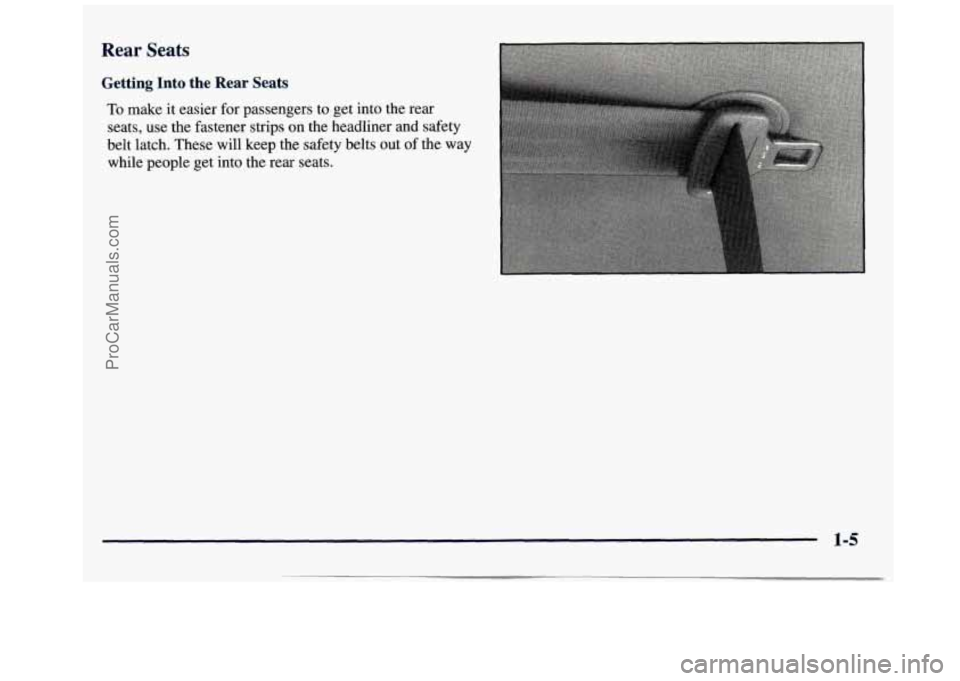
Rear Seats
Getting Into the Rear Seats
To make it easier for passengers to get into the rear
seats, use the fastener strips on the headliner
and safety
belt latch. These will keep the safety belts out
of the way
while people get into the rear seats.
1-5
ProCarManuals.com
Page 14 of 388
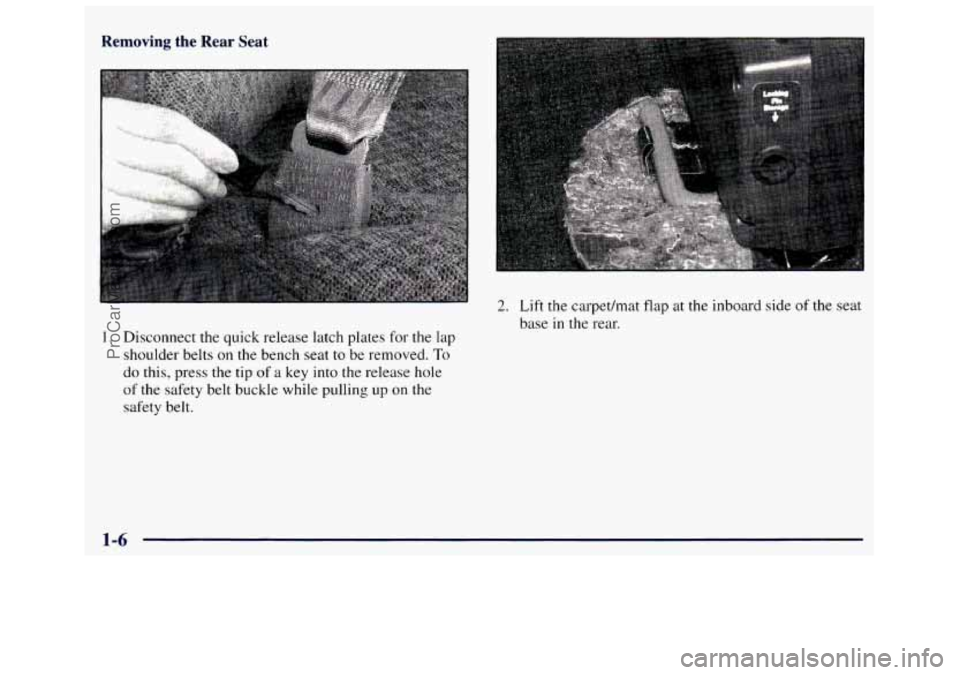
Removing the Rear Seat
1. Disconnect the quick release latch plates for the lap
shoulder belts
on the bench seat to be removed. To
do this, press the tip of a key into the release hole
of the safety belt buckle while pulling up on the
safety belt.
2. Lift the carpet/mat flap at the inboard side of the seat
base
in the rear.
1-6
ProCarManuals.com
Page 15 of 388
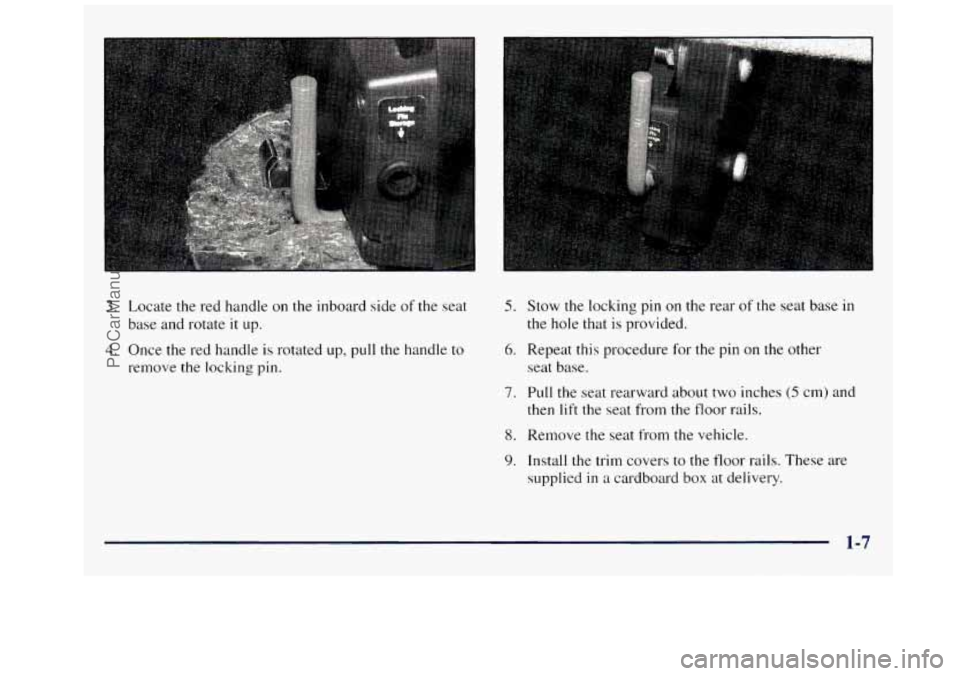
I
3. Locate the red handle on the inboard side of the seat
base and rotate
it up.
4. Once the red handle is rotated up, pull the handle to
remove the locking pin.
5. Stow the locking pin on the rear of the seat base in
the hole that is provided.
6. Repeat this procedure for the pin on the other
seat base.
7. Pull the seat rearward about two inches (5 cm) and
then
lift the seat from the floor rails.
8. Remove the seat from the vehicle.
9. Install the trim covers to the floor rails. These are
supplied in a cardboard box at delivery.
1-7
ProCarManuals.com
Page 16 of 388
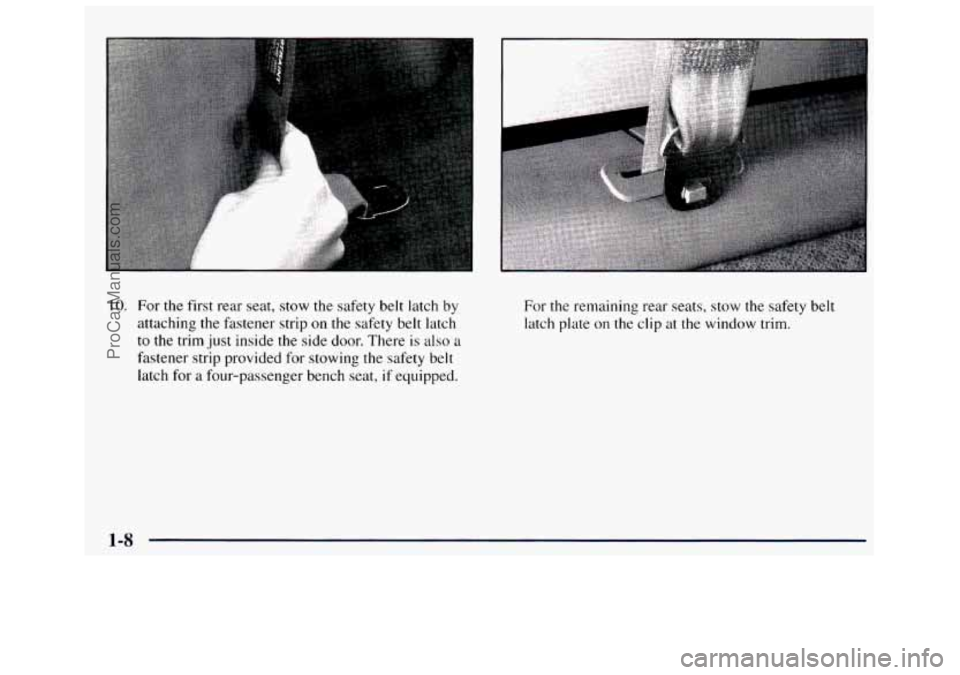
10. For the first rear seat, stow the safety belt latch by
attaching the fastener strip on the safety belt latch
to the trim just inside
the side door. There is also a
fastener strip provided for stowing the safety belt
latch for
a four-passenger bench seat, if equipped. For the remaining rear
seats, stow the safety belt
latch plate
on the clip at the window trim.
1-8
ProCarManuals.com
Page 17 of 388
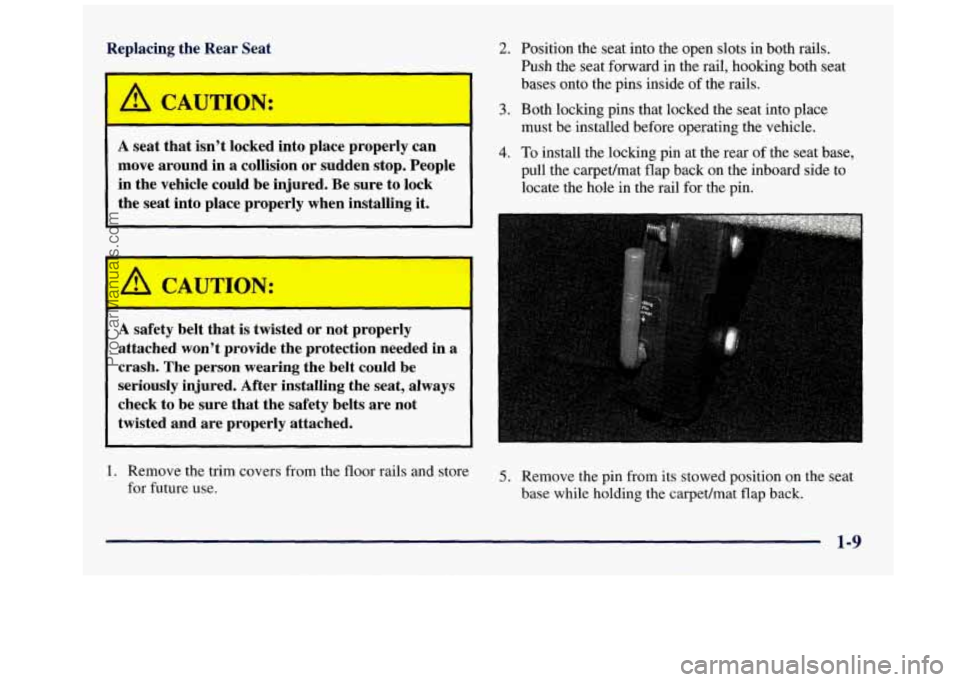
Replacing the Rear Seat
~~
/1 CAUTION.
A seat that isn’t locked into place properly can
move around in a collision or sudden stop. People
in the vehicle could be injured. Be sure to lock
the seat into place properly when installing it.
A safety belt that is twisted or not properly
attached won’t provide the protection needed in a
crash. The person wearing the belt could be
seriously injured. After installing the seat, always
check to be sure that the safety belts are not
twisted and are properly attached.
2. Position the seat into the open slots in both rails.
Push the seat forward in the
rail, hooking both seat
bases onto the pins inside of the rails.
3. Both locking pins that locked the seat into place
must be installed before operating the vehicle.
4. To install the locking pin at the rear of the seat base,
pull the carpetlmat flap back on the inboard side to
locate the hole in the rail for the pin.
1. Remove the trim covers from the floor rails and store
for future use. 5. Remove the pin from its stowed position on the seat
base while holding the carpetlmat flap back.
ProCarManuals.com
Page 18 of 388
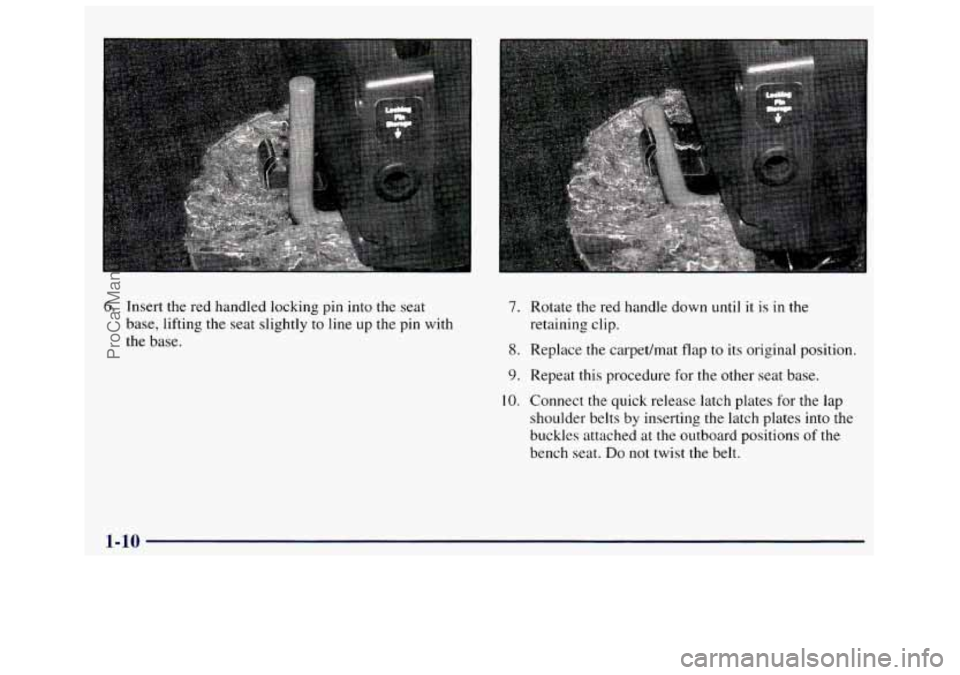
6. Insert the red handled locking pin into the seat
base, lifting the seat slightly to line up the pin with
the base. 7.
8.
9.
10.
Rotate the red handle down until it is in the
retaining clip.
Replace the carpet/mat flap
to its original position.
Repeat this procedure
for the other seat base.
Connect the quick release latch plates for the lap
shoulder belts by inserting
the latch plates into the
buckles attached at the outboard positions
of the
bench seat.
Do not twist the belt.
1-10
ProCarManuals.com
Page 19 of 388
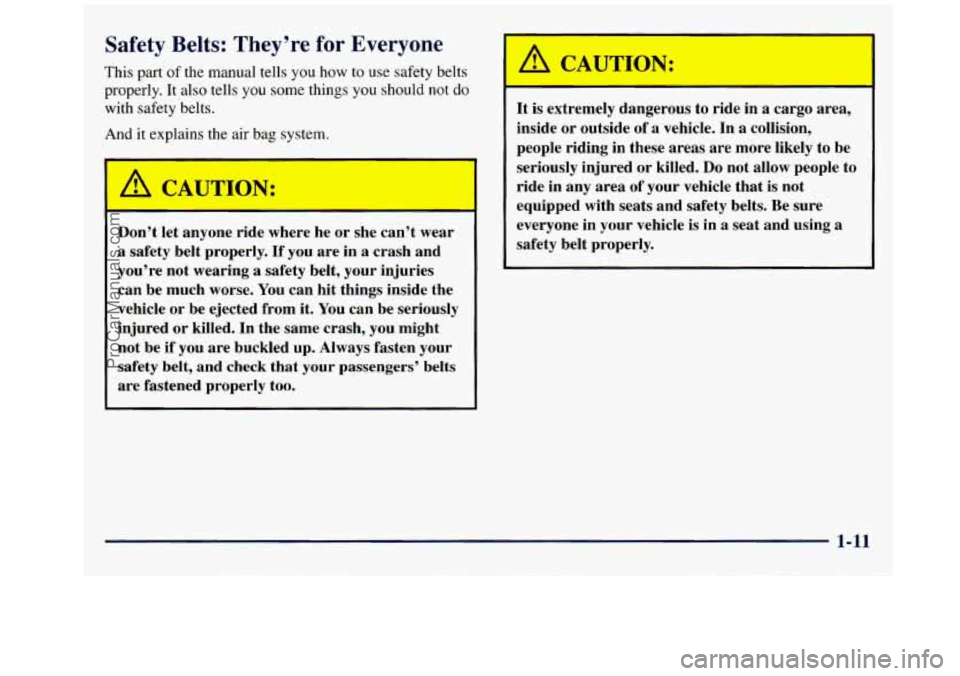
Safety Belt:- ~ -hey’re for Everyone
This part of the manual tells you how to use safety belts
properly. It also tells you some things
you should not do
with safety belts.
And it explains the air bs ;ys
A CAUTION:
Don’t let anyone ride where he or she can’t wear
a safety belt properly. If you are in a crash and
you’re not wearing a safety belt, your injuries
can be much worse. You can hit things inside the
vehicle or be ejected from it. You can be seriously
injured or killed. In the same crash, you might
not be
if you are buckled up. Always fasten your
safety belt, and check that your passengers’ belts
are fastened properly
too.
’ A CAUTION:
I
It is extremely dangerous to ride in a cargo area,
inside or outside of a vehicle.
In a collision,
people riding in these areas are more likely
to be
seriously injured or killed.
Do not allow people to
ride in any area of your vehicle that is not
equipped with seats and safety belts. Be sure
everyone in your vehicle is in a seat and using a
safety belt properly.
1-11
ProCarManuals.com
Page 20 of 388
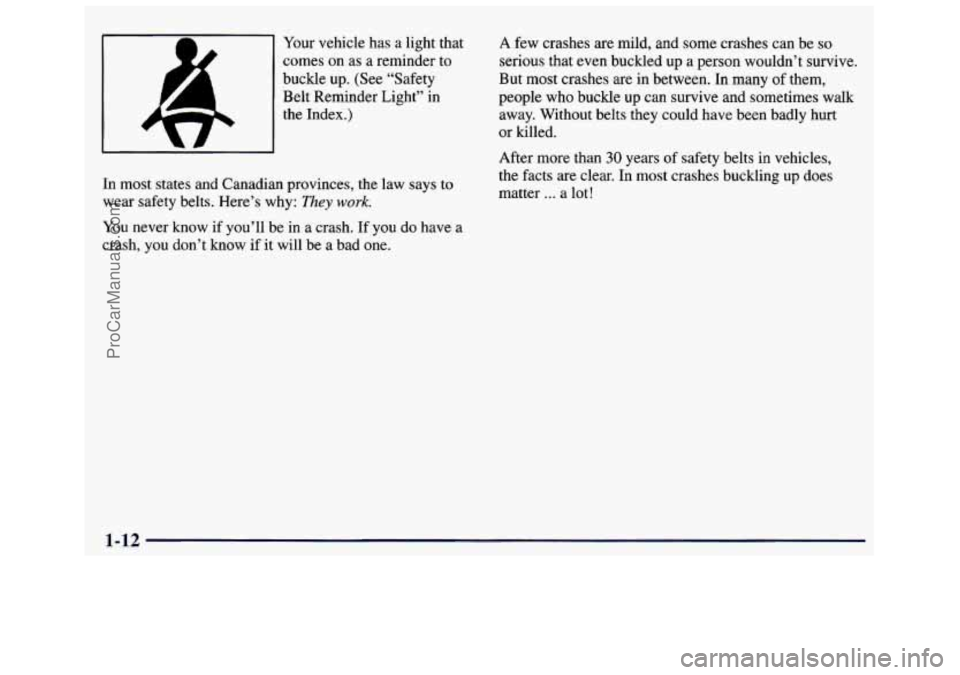
Your vehicle has a light that
comes on as
a reminder to
buckle up.
(See “Safety
Belt Reminder Light” in
the Index.)
In
most states and Canadian provinces, the law says to
wear safety belts. Here’s why:
They work.
You never know if you’ll be in a crash. If you do have a
crash, you don’t know if it will be a bad one.
A few crashes are mild, and some crashes can be so
serious that even buckled up a person wouldn’t survive.
But most crashes are in between. In many
of them,
people who buckle
up can survive and sometimes walk
away. Without belts they could have been badly hurt
or killed.
After more than
30 years of safety belts in vehicles,
the facts
are clear. In most crashes buckling up does
matter
... a lot!
1-12
ProCarManuals.com